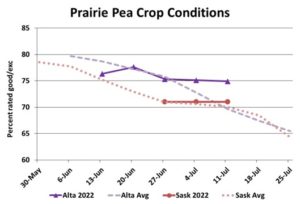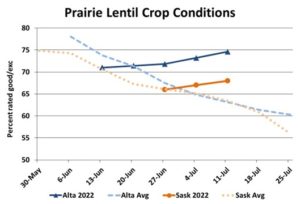Pulse Market Insight #213 JUL 22 2022 | Producers | Pulse Market Insights
Crop Conditions Looking Solid at a Key Time
It’s risky talking about crop conditions at any time of year. Ratings in crop reports are published at a single point in time and conditions are constantly changing. Invariably, crops in some areas will look worse than the ratings; others will be better. Some people have a hard time dealing with estimates that aren’t exactly right. We think crop conditions ratings should be viewed as a rough guideline, mostly as a comparison with previous years.
As the season advances, the ratings become more helpful, especially as the crop gets past some of the early risks. At this point, it’s not in the bin yet but there’s less that can go wrong. The ratings aren’t precise enough to translate directly to yield estimates, so some judgment is needed. With all those disclaimers, here are the condition ratings from Alberta and Saskatchewan crop reports.
As of mid-July, 75% of the Alberta pea crop was rated either good or excellent. That’s better than the 10-year average of 70% but it’s worth noting that the average is pulled down by the very poor conditions of 2021 and 2015. If we take out those two drought years, the average for Alberta peas would actually be 78%. In Saskatchewan, 71% of the 2022 pea crop is rated good/exc, just slightly above the 10-year average of 70%.

On the surface, these ratings suggest 2022 pea yields could be at or slightly above average. That said, the chart shows ratings normally decline throughout the season, possibly related to disease pressure or simply because a green crop early in the year somehow looks better than a mature crop. In contrast, 2022 crop conditions have been able to avoid those usual downgrades. This steady performance could turn into a strong finish to the crop and better yields. For now, our projections for 2022/23 are based on the pre-2021 5-year average yield of 38.9 bu/acre.
Lentil conditions in both provinces are also above average. In Alberta, 75% of lentils were rated good/exc as of mid-July compared to the 10-year average of 63%. Just like peas, the average rating is a mix of a few years of better years and some really bad years. The Saskatchewan ratings are lower at 68% good/exc but that’s still better than the 10-year average of 63%.

Crop ratings for lentils also tend to decline as the season progresses but in 2022, both Alberta and Saskatchewan ratings are rising, and that’s an important difference. Based on observations and feedback, it appears plant diseases are under better control this year and aren’t causing the same deterioration that often shows up as the year progresses. If that’s the case, it would point to above average yields. For now though, we’re a little gun shy (after the 2021 experience) and are still penciling in the pre-2021 average yield of 1,360 pounds (22.7 bushels) per acre.
We know crop ratings don’t reflect all parts of the province but overall, this year is looking good for pulse crops (cross fingers, touch wood, rub the rabbit’s foot). That’s already having the expected impact on prices but Canadian supplies are only one part of the market. That’s a topic for another day.
Pulse Market Insight provides market commentary from Chuck Penner of LeftField Commodity Research to help with pulse marketing decisions.
